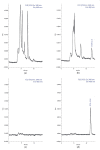Assessment of Ochratoxin A Exposure in Ornamental and Self-Consumption Backyard Chickens
- PMID: 32046067
- PMCID: PMC7157540
- DOI: 10.3390/vetsci7010018
Assessment of Ochratoxin A Exposure in Ornamental and Self-Consumption Backyard Chickens
Abstract
Ochratoxin A (OTA) is a mycotoxin that may be present in various food and feed of plant and animal origin, including chicken meat. In Italy, backyard poultry farming is rather widespread. Animals are raised for meat, eggs and for ornamental purpose, and they are often fed with home-made diets not subject to official controls. The purpose of this study was to evaluate exposure of ornamental and backyard chickens to OTA using biliary ochratoxin A as a biomarker. Therefore, bile samples, in addition to kidney, liver and muscle, were collected from 102 chickens reared in 16 farms located in 6 Italian regions. High-performance liquid chromatography method and fluorimetric detection (HPLC-FLD) analysis were carried out firstly on bile from all animals, and OTA was detected in 12 chickens (concentration range 3.83-170.42 µg/L). Subsequently, the kidneys of these chickens were also analysed, and the mycotoxin was not detected. The analytical detection limits (LODs) of OTA in bile and kidney were 2.1 µg/L and 0.1 µg/kg, respectively. In conclusion, these animals were exposed to OTA but their meat can be considered safe, given that this mycotoxin, if present, concentrates highest in kidneys. Biliary ochratoxin A confirms its use as a valid biomarker to assess exposure of poultry to OTA.
Keywords: HPLC-FLD; backyard chickens; bile; food safety; ochratoxin A.
Conflict of interest statement
The authors declare no conflict of interest.
Figures
Similar articles
-
Biliary ochratoxin A as a biomarker of ochratoxin exposure in laying hens: An experimental study after administration of contaminated diets.Res Vet Sci. 2015 Jun;100:265-70. doi: 10.1016/j.rvsc.2015.03.004. Epub 2015 Mar 6. Res Vet Sci. 2015. PMID: 25796369
-
Occurrence of ochratoxin A in typical salami produced in different regions of Italy.Mycotoxin Res. 2019 May;35(2):141-148. doi: 10.1007/s12550-018-0338-x. Epub 2018 Nov 20. Mycotoxin Res. 2019. PMID: 30460520
-
Ochratoxin A Levels in Tissues of Wild Boars (Sus scrofa) from Northern Italy.Toxins (Basel). 2020 Nov 8;12(11):706. doi: 10.3390/toxins12110706. Toxins (Basel). 2020. PMID: 33171643 Free PMC article.
-
The prevalence and concentration of ochratoxin A in meat and edible offal: A global systematic review and meta-analysis.Food Chem Toxicol. 2023 Aug;178:113921. doi: 10.1016/j.fct.2023.113921. Epub 2023 Jun 28. Food Chem Toxicol. 2023. PMID: 37390956
-
Ochratoxin A: its impact on poultry gut health and microbiota, an overview.Poult Sci. 2021 May;100(5):101037. doi: 10.1016/j.psj.2021.101037. Epub 2021 Feb 11. Poult Sci. 2021. PMID: 33752074 Free PMC article. Review.
Cited by
-
Content of Toxic Elements (Arsenic, Cadmium, Mercury, Lead) in Eggs from an Ethically Managed Laying Hen Farm.Animals (Basel). 2024 Apr 8;14(7):1133. doi: 10.3390/ani14071133. Animals (Basel). 2024. PMID: 38612373 Free PMC article.
-
Ochratoxin A in Poultry Supply Chain: Overview of Feed Occurrence, Carry-Over, and Pathognomonic Lesions in Target Organs to Promote Food Safety.Toxins (Basel). 2024 Nov 10;16(11):487. doi: 10.3390/toxins16110487. Toxins (Basel). 2024. PMID: 39591242 Free PMC article. Review.
-
Mycotoxin Residues in Chicken Breast Muscle and Liver.Foods. 2025 Jun 7;14(12):2017. doi: 10.3390/foods14122017. Foods. 2025. PMID: 40565626 Free PMC article.
References
-
- EFSA (European Food Safety Authority) Opinion of the scientific panel on contaminants in the food chain on a request from the commission related to ochratoxin A in food. EFSA J. 2006;365:1–56. doi: 10.2903/j.efsa.2006.365. - DOI


